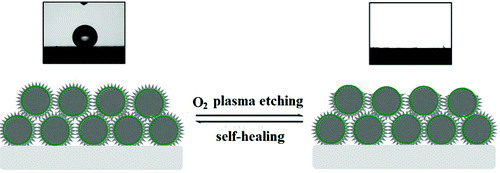Nature can rebuild the surface hierarchical structures and refresh the surface chemistry after damage and so the surface property. Inspired by nature, researchers at State Key Laboratory of Solid Lubrication, Lanzhou Institute of Chemical Physics (LICP), Chinese Academy of Sciences (CAS), have developed a general and feasible approach to prepare a self-healing hydrophobic surface without using any fluorocontaining compounds
 |
| |
The approach uses mesoporous silica as a reservoir material of octadecylamine (ODA) that can migrate to the surface consecutively and accomplish self-healing. A polymdopamine (Pdop) layer was used to further encapsulate silica−ODA because of the following three reasons. (1) Pdop provides a reactive layer and allows chemical bonding with ODA, so that hydrophobicity can be maintained in a wide pH range. (2) The Pdop layer allows more reversible etching−healing cycles by governing release of the underlying ODA. (3) It helps dispersivity, and so is used as an additive in bulk resin, e.g., polyurea. It is also interesting to discover that the Pdop@silica−ODA coating heals its superhydrophobicity under a wet and moist environment much faster than under a dry environment.
The work has received support from the National Natural Science Foundation of China. The findings have been published in Langmuir(Langmuir2012, 28, 5845−5849).

